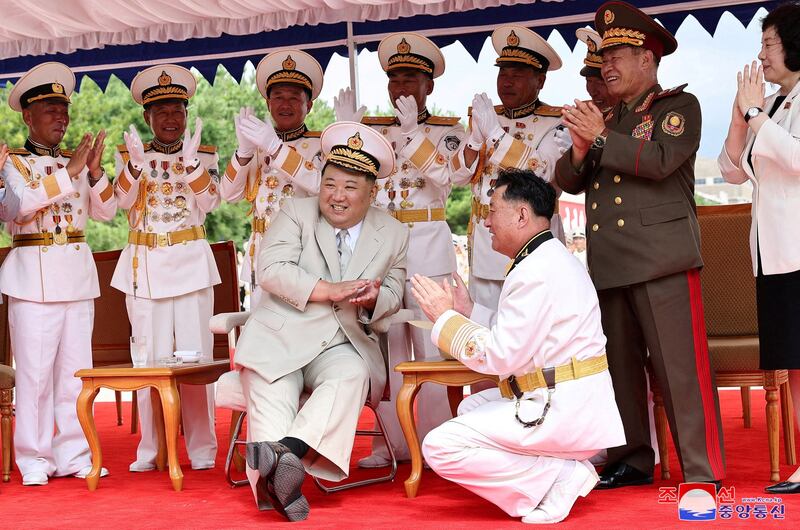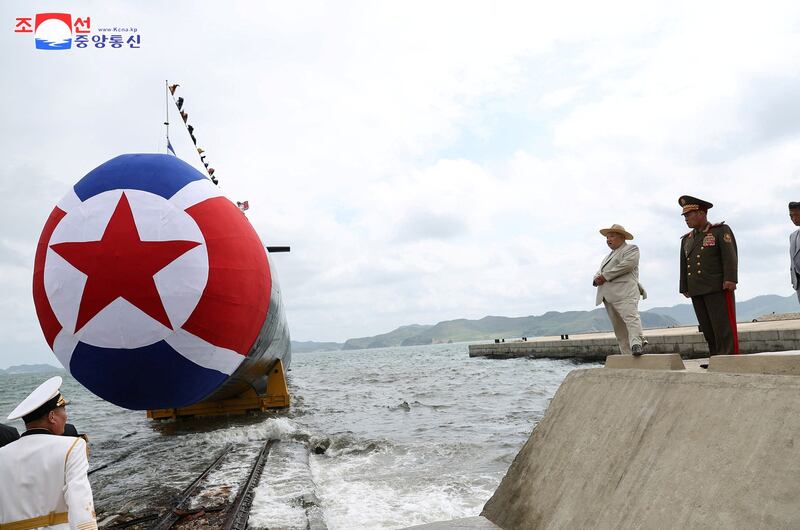North Korean leader Kim Jong Un has issued a fresh warning to the U.S. and its allies of a preemptive underwater nuclear strike, as he commissioned the authoritarian state’s first operational "tactical nuclear attack submarine" into waters that divide the Koreas and Japan.
"These submarines will be equipped with a vast array of nuclear delivery vehicles of varying power and will be poised to launch preemptive and retaliatory strikes at any time underwater," Kim said, according to the North’s official Korean Central News Agency Friday.
The North Korean leader, who attended the launch ceremony on Wednesday, said arming his navy with nuclear arsenal was an urgent task, and has pledged to equip more submarines with tactical nuclear weapons. He said that it was “exhilarating to imagine the elite nuclear underwater fleet that will pose a challenge to the enemy’s invasion fleet."
Pyongyang has increased its nuclear provocations in recent weeks while allying more closely with Russia and China, as the U.S., South Korea and Japan strengthened trilateral security cooperation in the region.
The unveiling of the submarine came on the eve of North Korea’s 75th founding anniversary, and is seen as a display of its escalating nuclear capability. North Korea has usually unveiled new weapons at the event that could pose a nuclear threat to the U.S. and its regional allies.

Named after a prominent North Korean historical figure, Submarine No. 841, or Hero Kim Kun Ok, was assigned to undertake its duties off the North’s eastern coast, KCNA said. The state media boasted that the submarine’s launch was ushering in a fresh era in enhancing naval prowess.
While the exact details of the new submarine is unknown, a South Korean military authority said that it is believed to be a modified 3,000t Romeo-class. North Korea's version of the Romeo-class submarines, capable of carrying its submarine-launched ballistic missile (SLBM) Pukkŭksŏng-1, is the diesel-electric Sinpo. The submarine has a range of 2,800 kilometers (1,740 miles). It is therefore widely seen as yet to acquire the ability to launch blue-sea operations. Even when factoring the Pukkŭksŏng-1's operational range, it could be widely seen to fall short of posing a direct threat to the U.S. mainland, which is around 10,000 km from North Korea's eastern coast.
Still, submarine-launched ballistic missiles present a challenge to the U.S. and its allies’ defense system due to their inherent stealth and unpredictability. Operating underwater complicates the existing radar detection system and makes it difficult to track North Korea’s military movements, disabling a preemptive strike.

“The ROK military has been using joint surveillance assets to track North Korea’s submarine activities in advance in coordination with the U.S.,” South Korea’s Joint Chief of Staff said in a statement Friday.
“Based on our analysis of the North Korean submarine's appearance to date, we believe that it appears to have increased the size and shape of some parts, such as the bridge, to accommodate missiles, but it does not appear to be operational,” the statement added, raising the possibility that North Korea may have exaggerated its capability.
“The modified submarines put South Korea and Japan under its range, and in theory, Guam as well,” said Cha Du-hyeogn, South Korea’s former presidential secretary for crisis information who is now a research fellow at the Asan Institute for Policy Studies.
“However, questions remain regarding its actual capabilities. It is still unconfirmed whether the submarine can withstand a missile strike, move silently underwater, or effectively launch an SLBM from beneath the surface.”
According to the KCNA report, Kim Jong Un has also revealed his intention to further enhance North Korea’s technological capability and expedite the creation of nuclear-powered submarines, which would enable blue-sea operations.
Kim’s ambition may inversely show North Korea’s lack the capability to construct a nuclear-submarine, Cha pointed out.
“While North Korea is interested in acquiring it, building one in the short term presents significant technical challenges. Military collaboration with Russia may occur in part to address this gap. But it would be difficult to imagine Moscow supplying Pyongyang with nuclear submarines or transferring relevant technologies. Even with the transferred technology, constructing a nuclear submarine within a short time frame remains a challenge to North Korea.”
Edited by Elaine Chan and Mike Firn.
